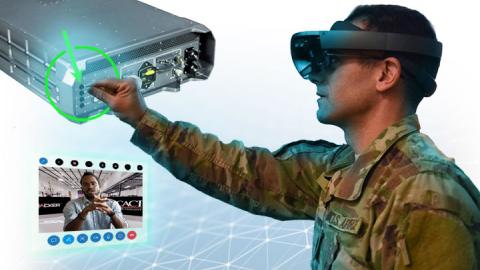CACI Q&A On Network Modernization
The revolutionary change in networks today is driven by the new technologies that are being introduced at an unprecedented rapid pace. 5G and software-defined networks propel us into a new stratosphere of capability, speed, and data accessibility. In addition, many U.S. Government agencies are shifting towards a more modern net of networks – enabling communications, sensors, and engagement across those mediums in a single network. These advances accelerate the ability to translate information into action, but also increase the pressure on protecting these critical networks from vulnerabilities and threats.
In the interview below, Ray Ivie, CACI Senior Vice President of Network Solutions, discusses how modern networks are the foundation for turning information into action in today’s rapidly evolving technological world and how CACI’s expertise in full lifecycle network solutions informs the development of new technologies we offer to help customers anticipate and embrace these rapid evolutions. If you wish to schedule an interview with Ray, please contact CACI Corporate Communications at [email protected].
With technology advancing at a rapid rate, how do CACI’s network modernization capabilities keep up… and what are they?
Modern networks are the foundation of almost all technology today – and it’s difficult to take advantage of advances in speed, agility, and security if the foundation is not modernized. Most users on a network don’t think about the complex cabling, routers, switches, hubs, gateways, servers, guards, and wired/wireless access points that seamlessly work to deliver the data we use. Understanding the needs for the network, then properly executing the architecture, design, integration, installation, security, and maintenance is needed to produce a cutting-edge network solution that truly meets the needs for the mission – now and in the future.
CACI provides full lifecycle network solutions at an enterprise scale to include network infrastructure architecture, design, and installation as well as network operations and sustainment. We lead the design, build, and maintenance of our network solutions both inside the plant – meaning the wiring of networks inside a communications facility, such as the cables connected to the physical server, and outside the plant – meaning the wiring of the networks that is necessary outside the facility, such as the cables connected to comms towers or facilities.
We’re operating in an information warfare environment. CACI advances the capabilities our customers currently have by creating the networks that enable communications and advanced sensors on a single network across the enterprise. This may sound simple, but it is a highly complex undertaking that is an emerging need in our industry. Everyone knows that the latest technologies improve the speed of the network, but these technologies can only go so far when information is segmented on multiple networks. Integrated networks offer the speed and flexibility that U.S. Government agencies need for their mission. They provide multi-level classification and integrated IoT and electro-optical/infrared sensors, enabling more rapid decision making and action. However with a more inter-connected network and more technology, comes the threat of more vulnerability. Cyber and network installation or operations can no longer be separated – cybersecurity is an intense focus for our customers as it is for us.
Besides our innovative marriage of operations, technology, and expertise, how is CACI’s network modernization different than other solutions?
We understand the importance of integrating cyber defense at every level of the network infrastructure. We do this on a large scale for several U.S. Government agencies. We leverage artificial intelligence, machine learning, and robotic process automation technologies, which help identify and fix any possible vulnerabilities.
Currently, there is also an emphasis on Commercial Solutions for Classified Data (CSfC) for transmission of classified data. Instead of running specific, individualized cabling, we can use the commercial infrastructure that is already in place with a mix of government information assurance products to provide an approved, modern and secure classified information network solution faster and cheaper. One of the advantages of CSfC solutions is that they don’t need to replicate infrastructure. Commercial services are also modernized more often allowing our customers to take advantage of newer built in security architecture and protections of the offerings.
5G is another game changer for the U.S. Government. It provides a tremendous increase in capability and speed. The implementation of 5G with millimeter wave capability across the military will open the door to many opportunities, enabling automation and coordinated and cooperative devices communicating with each other. It could even open up the ability to have autonomous vehicles in theater. However, such advances in capabilities, also opens up more cyber vulnerabilities in network entry points and will allow the spread of viruses faster, further and touching more devices than before. This makes the architecture and design of networks even more important and requires the inclusion of how other networks and devices interact.
CACI is fortunate to be a leader in the core development of 5G. We’ve been at the forefront of building 2G, 3G, and 4G technologies with the commercial equipment manufacturers over the past several decades. Now, we’re partnered with them again on the development of 5G capabilities. This deep knowledge and understanding of the 5G technologies will be critical to improve and secure the networks we modernize and develop for our U.S. Government customers.


